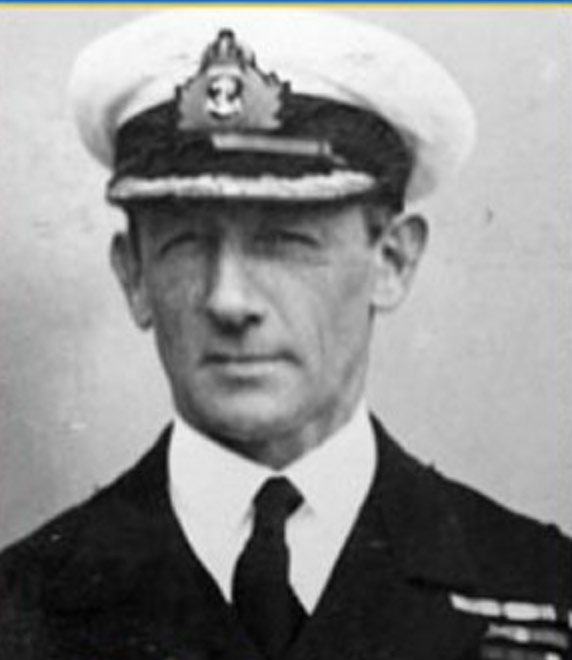Admiral Sir Gerald C. Dickens, Royal Navy (1879-1962) was involved with the Royal Netherlands Navy (RNLN)
for much of World War II. Dickens had retired as a vice admiral in
November 1938 after a long career, culminating in command of the
Reserve Fleet from 1935-37. With the outbreak of World War II, he was
recalled to active duty and temporarily assigned to planning duties at
the Admiralty.
********

The
war created tremendous personnel demands for the RN. The naval attaché
at the British embassy in The Hague was an active duty captain. This
officer was needed to command a cruiser and so a vacancy occurred. The
RN used retired officers recalled to active duty for a wide variety of
shore-based assignments including naval attaches. Dickens was likely
chosen as he had been Director of Naval Intelligence from 1932-35 and
spoke German and French. He arrived in The Hague on 8 February 1940 in
the rank of acting rear admiral and made early contacts with RNLN
officers, to the degree that Dutch neutrality permitted.
The German invasion of the Netherlands on 10 May 1940 quickly forced
the staff of the British embassy to evacuate the country. Early on the
morning of May 14 Dickens evacuated from the Scheveningen district of
The Hague on a lifeboat,
the Zeemanshoop, to the destroyer HMS
Malcolm which took him to Hook of Holland where the Maas River meets the North Sea. From there he was transported on the destroyer HMS
Wessex to Dover, arriving that same day.
Dickens remained involved with the RNLN as the naval attaché to the
British minister to the Netherlands government in exile and naval
liaison officer to the RNLN. This appointment ran from 16 May 1940 to 1
July 1940.
With the German conquest of Western Europe almost complete, the
Admiralty recognized the need to make use of the surviving Polish,
Norwegian, Netherlands, and French ships that sought refuge in British
harbours. On 2 July 1940 Dickens was appointed Coordinator of
Employment of Allied Seamen (CEAS), to oversee the naval and merchant
seamen of the European Allies. The title CEAS was changed on 18 August
1940 to Naval Assistant (Foreign) to the Second Sea Lord or NA(F)2SL.
In this capacity Dickens managed the official relationship between the
RN and the navies in exile of Poland, Norway, Netherlands, and France.
The title was changed yet again on 22 March 1942 to Principal Liaison
Officer, Allied Navies or PNLO. Dickens remained in this role, advising
the Allied navies about the RN and providing his assessment of the
Allied navies to the Admiralty.
In January 1943 Dickens was ready for a change of assignment so he
requested relief as PNLO. After a few months without an assignment,
once French North Africa joined the Allies he was sent in May 1943 to
Bizerte as Flag Officer Tunisia. Relieved in April 1944, he returned to
the UK.
The Allied invasion of France lead to his next assignment with the
RNLN. Allied troops moved into Belgium creating the prospect that the
Netherlands would soon be liberated. Dickens was appointed Flag Officer
Holland on 6 September 1944 as an acting vice admiral. Based in
Brussels, Dickens coordinated closely with Rear Admiral G.W. Stöve of
the Royal Netherlands Navy, the officer in charge of all Dutch naval
forces in the parts of the Netherlands that were under Allied control.
Dickens arrived in The Hague on 11 May 1945 and was relieved as Flag
Officer Holland on 10 September 1945.
************
The writings Dickens left behind, a 1946 article in the Naval Review titled “The Royal Netherlands Navy at war and after” plus his personal papers
in the Liddell Hart Military Archives, Kings College London, suggest
that he got along well with the Dutch. The Netherlands government
decorated Dickens for his services as naval attaché indicating the
Dutch had a positive view of Dickens. Any in depth examination of
British-Netherlands naval ties during World War II must consider the
important role Dickens played in facilitating a close and effective
relationship between the two navies. The photograph of him is from Wikipedia.







 The
war created tremendous personnel demands for the RN. The naval attaché
at the British embassy in The Hague was an active duty captain. This
officer was needed to command a cruiser and so a vacancy occurred. The
RN used retired officers recalled to active duty for a wide variety of
shore-based assignments including naval attaches. Dickens was likely
chosen as he had been Director of Naval Intelligence from 1932-35 and
spoke German and French. He arrived in The Hague on 8 February 1940 in
the rank of acting rear admiral and made early contacts with RNLN
officers, to the degree that Dutch neutrality permitted.
The
war created tremendous personnel demands for the RN. The naval attaché
at the British embassy in The Hague was an active duty captain. This
officer was needed to command a cruiser and so a vacancy occurred. The
RN used retired officers recalled to active duty for a wide variety of
shore-based assignments including naval attaches. Dickens was likely
chosen as he had been Director of Naval Intelligence from 1932-35 and
spoke German and French. He arrived in The Hague on 8 February 1940 in
the rank of acting rear admiral and made early contacts with RNLN
officers, to the degree that Dutch neutrality permitted.